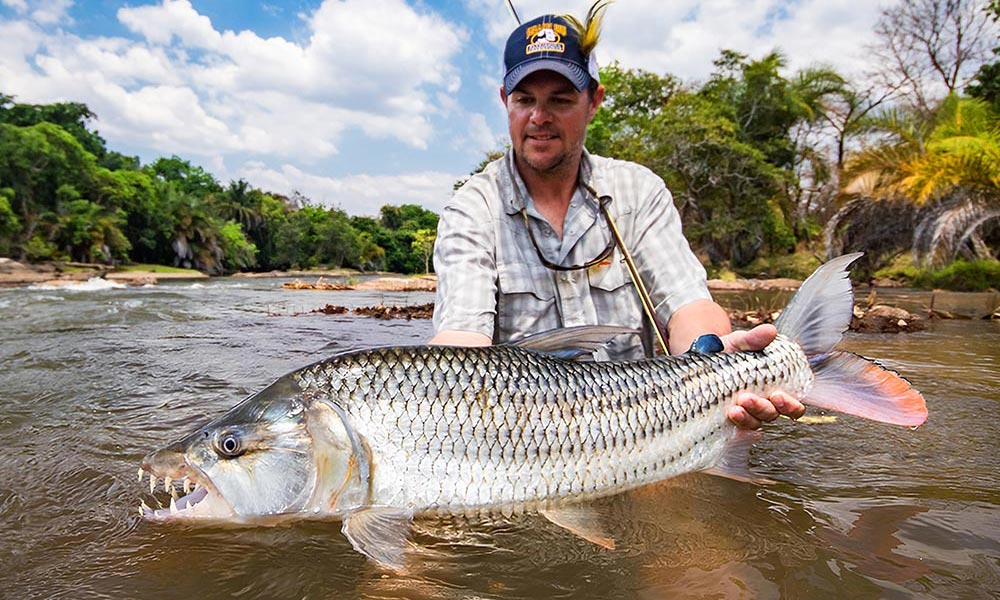Discover the best tigerfish destinations, guided trips, and lodge-based experiences worldwide. Explore remote waters and world-class angling with expert local hosts.

No results available
Tigerfishing is Africa’s most electrifying freshwater pursuit—marked by bone-jarring strikes, airborne fights, and powerful runs in big wild rivers. From Tanzania to the Zambezi, few species test your reflexes and gear quite like the tigerfish.
Tigerfish (Hydrocynus vittatus) are notorious for their aggressive takes, sharp teeth, and unpredictable surface explosions. Often compared to saltwater predators, they strike with force and fight with sustained speed. Anglers target them with heavy spinning gear, lures, or streamer flies in fast currents, eddies, and river drop-offs. While traditionally caught on conventional tackle, fly fishing for tigerfish has gained serious traction in recent years—especially on remote African rivers where pressure is low and water clarity allows for visual takes.
Whether drift-fishing from a boat or swinging flies from the bank, tigerfishing is some of the most intense freshwater predator fishing in the world—demanding quick reactions, wire leaders, and steady nerves when fish go airborne.
The Mnyera and Ruhudji Rivers offer some of the most productive tigerfishing in Africa. Anglers here encounter fish over 20 pounds in wild, clear rivers ideal for fly or spin.
From the Lower Zambezi to Lake Kariba, these regions are synonymous with tigerfish. Prime season brings aggressive surface action and high catch rates in both river and lake settings.
The Okavango and upper Zambezi systems hold serious fish, with fly-friendly conditions in certain stretches. Access is often by lodge or mobile camp.
The Panhandle and other sections of the Delta offer solid numbers of tigerfish, often mixed with bream and catfish, in classic African floodplain settings.
Remote and underfished, parts of the Congo River basin offer some of the largest tigerfish on the continent. These trips are typically expedition-style.
Tigerfish strike like lightning and fight like saltwater fish. Their explosive takes, brutal headshakes, and aerial runs make them one of the most exciting freshwater species in the world. Add to that the wild African settings—hippos, crocodiles, and remote rivers—and tigerfishing becomes a full-on adventure.
Tigerfish look like they swam out of another era—streamlined, silver-sided, and packed with menace. Their oversized jaws are lined with long, interlocking teeth you can see even with their mouth shut. Big, red-tinged fins and a deep forked tail hint at just how fast they move. Along the flanks, faint vertical bars give them a striped, almost prehistoric look. You don’t need to be close to know you’re dealing with a serious predator. Most fish run 5 to 10 pounds, but some reach well over 20—and they fight like they weigh twice that.
Water levels and clarity play a key role—lower, clearer rivers often produce the best tigerfishing, especially on the fly.
FishingExplora features tigerfishing lodges in Tanzania, where fly and spin anglers target big tigerfish in remote, clear rivers. These trips combine skilled guiding, mobile or tented lodges, and exclusive access to some of Africa’s wildest freshwater fisheries. Other tigerfishing hotspots include the Zambezi, Okavango, and Congo systems—offering diverse styles, scenery, and levels of adventure.
Tigerfish are explosive fighters. They hit like a truck, jump aggressively, and often throw hooks mid-air. Strong gear and quick reflexes are essential for landing them—especially in fast current.
Yes. Tigerfish are excellent fly targets in clear, fast rivers. Use wire leaders, 8–10 wt rods, and streamers stripped quickly near structure or current seams. Takes are visual and hard-hitting.
Tanzania’s Mnyera and Ruhudji rivers are top-tier, especially for fly fishing. The Lower Zambezi and Okavango Panhandle also offer strong numbers, good logistics, and seasoned guides.
Use an 8–10 wt fly rod or medium-heavy spinning setup. Wire leaders are essential. Flies should mimic baitfish; for spin, use crankbaits, spoons, or jigs with strong hooks.
They’re not dangerous to humans unless handled carelessly. Tigerfish have sharp teeth and strong jaws—use pliers and care when unhooking. In the water, they’re all about the hunt.